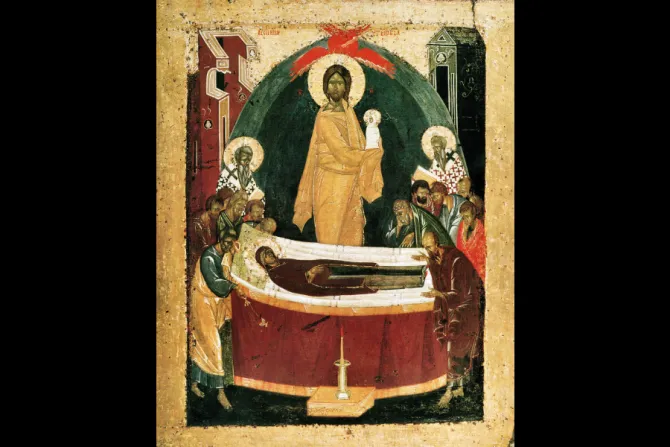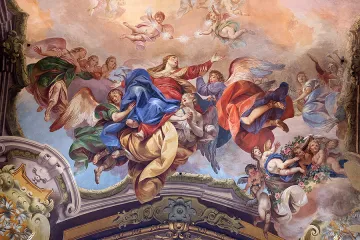Rome, Italy, Jul 31, 2019 / 02:01 am
Each year the Eastern Catholic Churches, as well as other Eastern Christians, participate in a fasting season Aug. 1-14 in preparation for the Aug. 15 feast of the Dormition of the Mother of God (which is celebrated as the Assumption in the Latin rite).
Traditionally, during the strict fourteen day fast, Eastern Catholics abstain from meat, dairy, fish, wine, and oil on weekdays, with some relaxation on the weekends and on the feast of the Transfiguration. The fast is relaxed for children and the elderly, or for those with a medical condition.
The text from one of the prayers in the Vigil of the Dormition in the Byzantine rite reads: "O peoples, dance with joy and clap your hands with fervor; gather today in eagerness and jubilation and sing with glee, for the Mother of God is about to rise in glory, going up from the earth into heaven. It is to her we always sing hymns of praise, for she is the Mother of God."
The Paraklesis, also known as the Office of Consolation to the Most Holy Theotokos, consists of a set of prayers sung in the Byzantine rite throughout the preparatory fast with the repeated invocation, "Holy Mother of God, save us!"
For more than 40 years Santa Maria in Via Lata, a Roman basilica, has celebrated this "Little Lent of the Mother of God" with nightly sung prayers taken from both Byzatine and Latin rite texts.
The basilica says that with this unique fusion of prayers, both the East and the West together, honor the Queen of Heaven. This year, prayers will include intercessions for Christian unity, for families, and for peace, particularly in the Middle East and in Eastern Europe.
The 17th-century Santa Maria in Via Lata – located on Via del Corso, one of Rome's busiest shopping and tourism streets – also has Eucharistic adoration each day beginning at 5:00pm.
Prior to the construction of the current basilica, Byzantine monks are thought to have had a monastery on the site in the 8th century. Underneath the basilica is a crypt containing Eastern-style frescoes dating back to the 7th century.
The crypt also has an excavation of a Roman house where tradition holds St. Luke once lived and St. Paul visited during the two years of his imprisonment in Rome, according to the basilica.
The two weeks of prayer in Rome will culminate in a solemn vigil for the Feast of the Assumption of Mary Aug. 14 at 8:00pm in the Basilica of Saint Mary Major, the preeminent church dedicated to the Mother of God in Rome. A choir made up of sisters from the Compassionist Sisters Servants of Mary will sing the evening prayers for the vigil.
The dogma of the Assumption of Mary – called the "Dormition of Mary" in the Eastern Churches – has its roots in the early centuries of the Church. The Catholic Church teaches that when Mary ended her earthly life, God assumed her, body and soul, into heaven.
According to St. John of Damascus, at the Council of Chalcedon in 451, Roman Emperor Marcian requested the body of Mary, Mother of God. St. Juvenal, who was Bishop of Jerusalem, replied "that Mary died in the presence of all the Apostles, but that her tomb, when opened upon the request of St. Thomas, was found empty; wherefrom the Apostles concluded that the body was taken up to heaven," the saint recorded.
The belief in the Assumption of Mary was a widely-held tradition, and a frequent meditation in the writings of saints throughout the centuries. However it was not defined officially until the past century. In 1950, Venerable Pius XII defined the Assumption as a dogma revealed by God.
Along with the dogma of the Assumption, it is the more common opinion among theologians that Mary suffered a temporal death.
The Dormition (Assumption) is a holy day of obligation in both the Latin rite and among the Eastern Catholic Churches.




